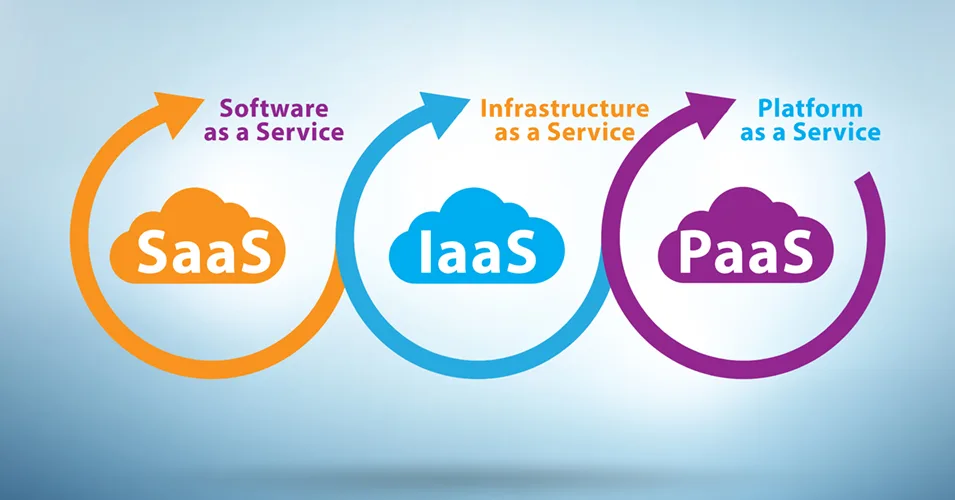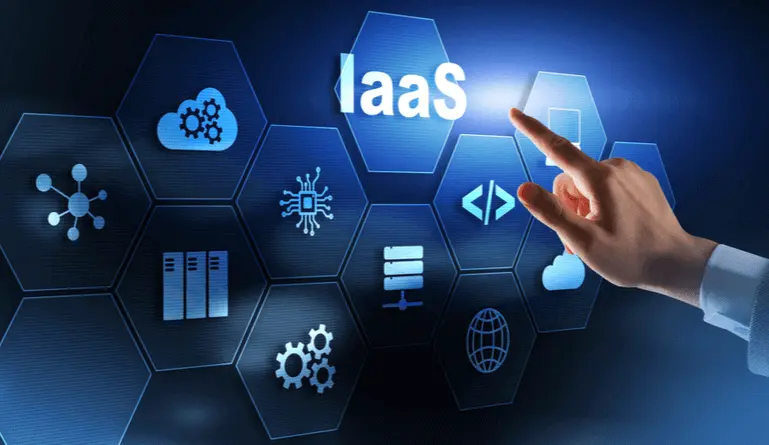Infrastructure as a service, or IaaS, is a cloud service that provides essential computer resources like storage, networking, and computing power over the Internet. With IaaS, you don’t have to buy and manage your physical servers and other Infrastructure. Instead, you rent these resources from large data centers on a flexible, pay-as-you-go basis.
Some key things you get with IaaS include:
- Virtual machines to host your applications and workloads
- Storage in the cloud for your files and data
- Networking tools to connect apps and resources
- Security features to keep your info protected
- Mechanisms for monitoring performance and costs
IaaS saves businesses money by eliminating upfront costs for hardware. It also provides instant access to flexible resources that can quickly scale up or down based on your needs. This guide will explain the basics of IaaS and how it can benefit your company.
What is IaaS?
Now that we’ve introduced IaaS, let’s dive deeper into understanding the key aspects that make it work. At its core, IaaS provides three fundamental types of cloud resources: computing, storage, and networking.
Computing
IaaS fulfills your computing needs through virtual machines (VMs). These are software-based computer systems that behave just like physical machines. You can install your choice of operating system and applications on VMs. Some providers let you choose the number of CPU cores and the amount of RAM for each VM. It allows you to right-size your VMs for different workloads.
Storage
For storage, IaaS offers options like block storage for databases and file storage for general files. Object storage is also famous for storing massive amounts of unstructured data in a simple format. All your files are securely stored in the provider’s data centers and accessible online. You only pay for the actual storage space you use.
Networking
IaaS provides virtual networks that connect your various cloud resources securely and reliably. Tools like load balancers help distribute traffic efficiently across multiple VMs. You can also build virtual private clouds within public cloud data centers for additional security and privacy.
Management and Monitoring
Managing VMs, storage volumes, and networks can get complex as your usage grows. IaaS vendors offer centralized management consoles to simplify administration and monitoring tasks. You can quickly provision or delete resources, apply automated security patches, and get usage analytics for spending visibility.
Scalability and Flexibility
One big perk of the cloud is adding or removing resources on demand. With IaaS, you can completely scale your Infrastructure up or down within minutes based on changing workload needs. There’s no need to over-provision capacity upfront or spend time selling unused hardware later. You only pay for what you use, making IaaS cost-efficient for variable usage.
IaaS Models Explained

Now that we have covered the basics of IaaS let’s look more closely at the available models. IaaS providers offer flexibility in how infrastructure resources are delivered and managed. The right model choice depends on your specific control, security, compliance, and cost needs.
Cloud IaaS: The standard IaaS approach is where all resources run inside a provider’s data centers. Compute, storage, and networking services are accessed online through standardized APIs or a web interface. Cloud IaaS gives instant scalability but has fewer customization options than other models. Some popular cloud IaaS vendors are AWS, Azure, and GCP.
Bare Metal IaaS: Bare Metal IaaS delivers dedicated physical servers that are not virtualized or shared with other customers. You have complete administrative control and can install any desired operating system. It provides high performance that is suitable for demanding workloads like scientific modeling. However, flexibility and scalability are more limited compared to cloud IaaS.
Private IaaS: A private cloud deploys IaaS infrastructure within your data center or a co-location facility. It gives you dedicated hardware resources while keeping data and applications securely behind your firewall. Management is similar to public cloud IaaS. While offering enhanced security and customization, private IaaS requires capital expenditure and operational overhead.
Hybrid IaaS: A hybrid model combines private and public clouds for a flexible “as-a-service” environment. Non-sensitive workloads run in the public cloud for scale, while sensitive systems are isolated in your private cloud or on-premises. This hybrid approach helps optimize costs while meeting complex compliance needs.
Major IaaS Providers
With IaaS rapidly growing, many providers are competing for your business. Let’s examine some of the most prominent players and what makes each stand out. Proper due diligence is essential before committing to any vendor long-term.
AWS
Amazon Web Services is the clear market leader, with over 200 cloud services available globally. Known for innovation, AWS pioneered the public cloud and has the largest network of data centers worldwide. It offers the most comprehensive IaaS capabilities like EC2, S3, and VPC. Great for developers and startups.
Microsoft Azure
As a close second, Azure is a powerful option for Windows-based applications and DevOps. It has strong integration with other Microsoft products and tools. Due to tight Office and Active Directory integration, Azure best suits large enterprises with existing Microsoft investments.
Google Cloud Platform
GCP prioritizes machine learning, analytics, and containers with services like Kubernetes Engine. It has a reputation for performance leadership and a simple pricing model. An excellent choice for cutting-edge AI/ML workloads or customers heavily invested in Google’s G Suite.
Alibaba Cloud
The largest cloud provider in Asia, Alibaba Cloud, is proliferating outside China, too. It offers excellent value with competitive pricing and features targeting e-commerce use cases—a good fit for companies expanding business in Asia or those with Alibaba experience.
IBM Cloud
IBM’s public cloud focuses on security, open-source support, and enterprise workloads. It has robust capabilities for highly regulated industries like healthcare, finance, and government. IBM Cloud is best for compliance-sensitive clients or those with existing IBM software.
While these are the most prominent names, many other IaaS providers also address specific niches. Carefully evaluating your technical needs and business priorities will lead you to the right partner.
Migrating to IaaS
Transitioning applications and workloads to IaaS is essential, but proper planning is critical to a smooth migration. Jumping in could impact operations or incur unexpected costs. Let’s examine some best practices for assessing your environment and selecting the right approach.
Workload Assessment
Start auditing all in-house systems to understand hardware dependencies, usage patterns, and compliance needs. It will help determine candidate apps and a rough timeline. Consider performance requirements, connectivity demands, and integration with other services.
Migration Strategies
Multiple strategies depend on your goals. Lift and shift move apps “as is” to the cloud. Replatforming refactors code for a cloud-native architecture. Refactoring rebuilds apps from scratch as cloud-optimized microservices. Choose based on app complexity and available resources.
Testing and Validation
Gradually migrate non-critical systems first to test IaaS functionality. Validate apps are operating as expected and meeting SLAs. Thoroughly test disaster recovery procedures. Retire on-prem hardware only after production workloads pass all reviews.
Deployment Best Practices
For reliability, deploy apps across multiple availability zones. Consider a private cloud or hybrid model if low-latency access to on-prem systems is vital. Automate infrastructure-as-code for repeatable, versioned deployments. Plan network topology with security and performance in mind.
The cloud transition requires careful planning, but IaaS delivers immense scalability and cost benefits.
Managing IaaS
Once your applications are up and running in the cloud, ongoing management is crucial. While IaaS vendors handle physical Infrastructure, you are responsible for the software stack and associated responsibilities. Let’s explore some best practices for effective cloud administration.
Monitoring Performance: Use the provider’s monitoring services to track metrics like CPU/memory usage, network traffic, and storage IOPS. Set up alerts for issues or anomalies. Third-party tools also integrate for cross-cloud visibility. Keep an eye on workloads to quickly scale resources as needed.
Updating Software: Automate security patching of operating systems and applications. IaaS platforms regularly update their software, so test compatibility and upgrade your AMIs/images proactively. Outdated systems are vulnerable attack targets.
Securing Resources: Enforce strong access controls and multi-factor authentication. Monitor logs to detect unauthorized access. Use security groups to filter traffic and isolate systems. Regular audits ensure compliance with policies and regulations over time.
Optimizing Costs: Analyze spending reports to eliminate unused resources that incur costs when idle. Stop non-critical systems as needed to save expense. Take advantage of reserved instances for predictable long-term usage. Automate scaling to optimize performance per dollar.
Disaster Recovery: Establish failover procedures to maintain business continuity—leverage provider replication tools to keep copies of data and AMIs in separate regions. Conduct mock drills to validate that RTO/RPO can be achieved as designed.
The Future of IaaS

The cloud infrastructure market rapidly evolves with new technologies that promise even greater scalability, automation, and cost savings. Let’s explore emerging trends likely to impact IaaS delivery and management.
Serverless Computing: With serverless architectures, developers don’t have to manage servers – a cloud provider automatically handles scaling. Functions are run in response to events billed based on execution time rather than reserved capacity. It simplifies coding and optimizes costs for unpredictable usage.
Containerization: Docker and Kubernetes are making containers mainstream for packaging and running distributed applications. IaaS vendors are enhancing platforms to support container orchestration at scale natively natively. Containers improve cloud portability and allow for proper “infrastructure as code.”
Edge and Multi-cloud: To reduce latency for IoT and mobile use cases, expect more Infrastructure to move closer to endpoints at the network “edge.” Hybrid and multi-cloud strategies will also gain prominence for workload portability and disaster recovery across providers.
Machine Learning Operations: Leveraging AI for autonomous management tasks like predictive scaling, anomaly detection, security monitoring, and recommendations could optimize cloud infrastructure utilization beyond human capabilities.
Those are some of the significant trends that will shape IaaS delivery in the coming years. Of course, innovative new services and models will continually emerge as technology advances. The cloud remains an exciting arena of rapid change.
Conclusion
- The key components that make up an IaaS solution include virtual machines, storage, and networking
- Different IaaS models like cloud, bare metal, private, and hybrid cloud and when each is best suited
- Major IaaS vendors in the market today and what differentiates their offerings
- Best practices for migrating workloads from on-premise to the cloud
- Ongoing management responsibilities in IaaS and how to optimize costs
- Emerging technologies that will continue shaping the future of IaaS, like serverless computing, containers, and edge infrastructure
Frequently Asked Questions
How much does IaaS cost compared to owning Infrastructure?
IaaS is often more affordable than owning physical servers long-term. You pay only for resources used, avoiding significant upfront costs. Costs vary by provider and usage, but typically, you’ll save 30-50% versus on-prem. IaaS lets you choose the right size of spending each month based on needs.
What workloads are best suited to IaaS?
IaaS is ideal for stateless apps, dev/test environments, and workloads with fluctuating demand. It also excels at data analytics, AI/ML models, and websites. Workloads with intensive storage, networking, or computing can leverage near-unlimited cloud scale. IaaS gives more control for mission-critical apps than SaaS.
What security risks do I need to consider with IaaS?
As with any shared environment, ensure credentials and access are adequately secured. Enable multifactor authentication and regularly audit logs. Use security features provided by cloud vendors and keep software updated. Maintain offline backups and disaster recovery plans. A risk-based approach helps address threats while leveraging IaaS flexibility.
How do I optimize costs and prevent bill shock with IaaS?
Closely monitor usage to remove unused resources. Stop non-production systems as needed. Use reserved or spot instances for steady-state workloads. Enable auto-scaling to optimize for demand. Consolidate services onto the most extensive instance types cost-effectively. Negotiate for volume discounts—tag resources and set budgets to track spending.
What skills are required to manage IaaS?
A cloud architect or admin needs experience with OS, networking, databases, and automation tools. They should understand service APIs, security best practices, cost optimization, and monitoring. DevOps skills are valuable for container and serverless applications. Experience with major IaaS platforms gives flexibility across providers. Certifications also validate cloud expertise.



